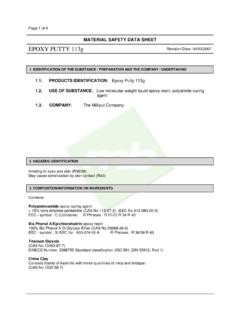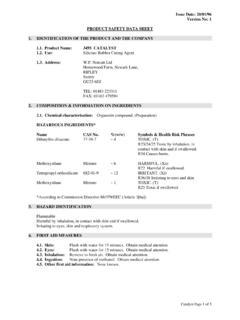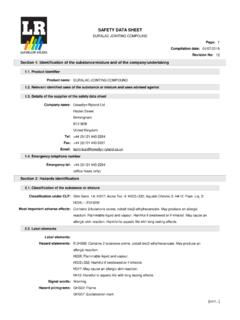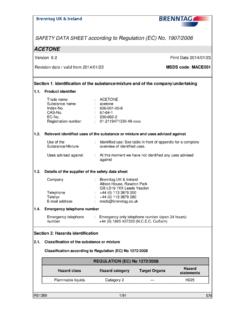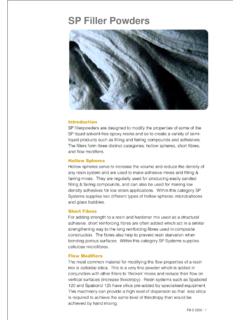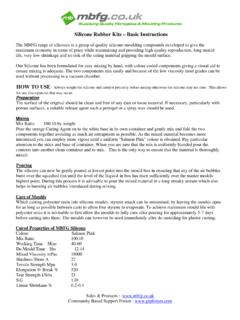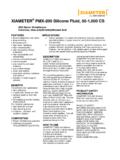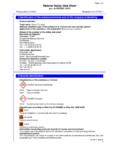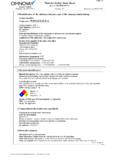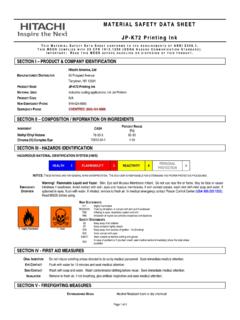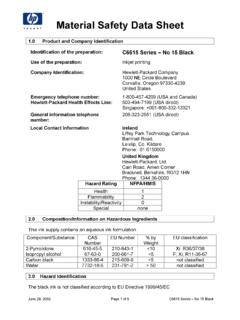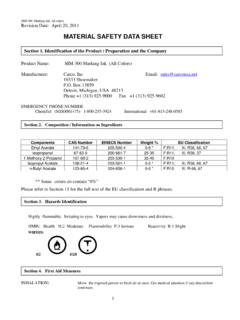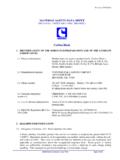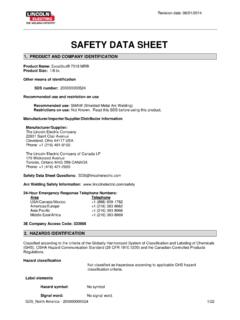Transcription of Material Safety Data Sheet 91/155/EEC
1 Material Safety data Sheet 91/155/EEC Revised : 27 / 03 / 2007 Date of printing : 22/10/2007 Page : 1 / 4 1. Identification of the Substance / Preparation and Company Product Name & Use : Fine Casting Plaster, Fine Casting Plus, Superfine Casting Plaster, Helix, Herculite , Herculite Stone, Crystacal R, Crystacal RS, Crystacast, Crystacal Alpha K, Herculite Fibrefix, Teknicast, Standard Casting Plaster Plaster for use in the production of giftware, fibrous/GRG moulding and for general plaster casting Manufacturer / Supplier : BPB Formula Bowbridge Lane Newark Nottinghamshire NG24 3BZ United Kingdom Telephone 0044 (0) 1636 670200 2. Hazards Identification Description of hazard: These products are not classified as dangerous/hazardous under Chemicals (Hazard Information and Packaging for Supply) Regulations 2002 (Chip 3).
2 Additional effects for people and environment: This Material will harden and become very hot when mixed with water. Avoid skin contact and do not attempt to make a cast enclosing any part of the body. If these instructions are not followed, severe burns could result leading to surgical removal of the affected skin or even amputation of the limb. Powders may irritate eyes or sensitive skin Dust may irritate respiratory system 3. Composition / Information on Ingredients Chemical composition: Principally calcium sulphate hemihydrate and natural constituents, which may include clay, limestone and trace amounts of quartz. Minor amounts (less than ) of other additives may be included CaSO4 x 0,5 H2O CAS number 26499-65-0 (Plaster of Paris) Einecs number 231-900-3 Dangerous substances: CAS No. Name Content R - Phrase Category of Danger OEL None None None None None None Refer to section 16 - Other Information for full details of R-Phrases and danger categories Other Substances: Substances with Community Workplace Exposure Limits CAS No.
3 Name Content WEL Long Term (8hr) WEL Short Term (15 min) 26499-65-0 Plaster of Paris >90% 10 Inhalable 4 Respirable None position / Information on Ingredients 2. Composition / Information on Ingredients 4. First-Aid Measures General instructions: Medical attention is advisable if any symptoms persist Inhalation: Remove person to fresh air Skin contact: Flush skin with running water before washing with water and soap Material Safety data Sheet 91/155/EEC Revised : 27 / 03 / 2007 Date of printing : 22/10/2007 Page : 2 / 4 Eye contact: Wash the eyes, including opening eyelids, with plenty of clean water (minimum 15 minutes) and seek medical advice if irritation persists Ingestion: Wash out mouth and drink plenty of water Specific information for Doctor: None 5. Fire Fighting Measures Suitable extinguishing media: All fire extinguishers are suitable media observing normal fire fighting procedures For Safety reasons extinguishing media which must not be used: None Special exposure hazards arising from dust combustion or gas development: At high temperatures (more than 1200 0C) sulphur trioxide will be produced Special protective Safety equipment for fire fighting: None Additional information: The product will not support combustion but the packaging may burn 6.
4 Accidental Release Measures Personal precaution measures: Control and suppress dust formation Environmental precaution measures: Prevent powder contaminating drains and watercourses Prevent slurry contaminating drains and watercourses Method of cleaning / sweeping up: Mechanical pick up (vacuum) or sweep and shovel into bags Refer to section 8 Exposure Controls/Personal Protection Refer to section 13 Disposal Considerations 7. Handling & Storage Handling: Minimise and control dust when opening bags, mixing powder with water or sanding set plasters Avoid prolonged or repeated contact with the skin or any eye contact Wear protective clothing when mixing or working with powdered or wet plasters Storage: Supplied in bags, on pallets. Store in dry conditions and on firm level ground to maintain pallet stability If manually handling use correct Manual Handling techniques 8. Exposure Controls / Personal Protection Exposure Limit Values: Components with exposure limit values (workplace exposure limits or biological limit values) CAS No.
5 Substance WEL Long Term (8hr) WEL Short Term ( 15 min) 26499-65-1 Calcium Sulphate (Plaster of Paris) 10 Inhalable 4 Respirable - - Quartz (Silica) Respirable - Exposure Controls: 1) Occupational exposure controls Respiratory protection: Material Safety data Sheet 91/155/EEC Revised : 27 / 03 / 2007 Date of printing : 22/10/2007 Page : 3 / 4 Control dust formation and ventilate the area of work. If dust concentration is above occupational exposure limits then a respiratory filter/face mask to EN 149 :2001 FFP1 minimum should be worn Hand protection: To avoid prolonged or repeated wet contact wear impermeable gloves. To reduce the effect of hand contact apply a barrier cream Eye protection: If plaster contact or splashes are likely wear Safety goggles to BS EN 166 Body protection: To avoid skin contact wear protective overalls and footwear 2) Environmental exposure controls: Gypsum based preparations are not known to have high potential to damage the environment 9.
6 Physical and Chemical Properties General Information: Appearance: Solid in powder form, off white Odour: Odourless, except occasionally slight musty odour Important health, Safety and environment information: pH value 6-8 in 10% aqueous solution (distilled) Relative Density Approx. g / cm Solubility in water Approx. g / L Other information: Thermal decomposition to CaSO4 and H2O approx. 140 C Thermal decomposition to CaO and SO3 approx. 1200 C 10. Stability & Reactivity Under normal conditions of use these products are stable and unreactive: Conditions to avoid: No dangerous reactions are known Materials to avoid: None Hazardous decomposition products: None under normal conditions of use When working with higher temperatures (over 1200 degree Centigrade) hazardous sulphur trioxide can develop. 11. Toxicological Information Toxicological (health) effects: No known available evidence indicating adverse toxicological health effects for acute toxicity, corrosivity/irritation, sensitisation, repeated-dose toxicity, mutagenicity, carcinogenicity, or reproductive toxicity.
7 Exposure: Inhalation Plaster dust may irritate respiratory system, no known long term effects Ingestion- Small amounts of plaster or wet mix should not cause any significant reaction or long term effect Skin contact- Plaster powder may dry skin leading to irritation if contact is prolonged or skin is sensitive Eye contact Powder or wet mix splashes may irritate by particulate in the short term 12. Ecological Information No known negative ecological effects Products are sparingly soluble in water, forming a solution/slurry and solidifying 13. Disposal Considerations Packaging disposal: Dispose of empty bags in accordance with local Environment Agency Regulations Material Safety data Sheet 91/155/EEC Revised : 27 / 03 / 2007 Date of printing : 22/10/2007 Page : 4 / 4 Product disposal: Dispose of product in accordance with local Environment Agency Regulations 14.
8 Transportation Information No special precautions exist with respect to transport Not classified as hazardous for transport 15. Regulatory Information Safety data Sheet prepared in accordance with: Chemicals (Hazard Information & Packaging for Supply) Regulations 2002 - CHIP 3 Approved Code of Practice (L130). The compilation of Safety data sheets Third edition The Control of Substances Hazardous to Health 1999 (COSHH) COSHH Essentials: Easy steps to control chemicals 16. Other Information Sources of key data used to compile Safety data Sheet : Approved classification and labelling guide Guidance on regulations L131 Approved Supply List (L129) Seventh edition HSE EH40 Occupational Exposure Limits (current edition) This information reflects typical values and is not a product specification No warranty is hereby expressed or implied Note to user: This Safety data Sheet does not constitute the users own workplace risk assessment, which is required under COSHH Regulations 1999 Written enquiries should be addressed to: BPB Formula Bowbridge Lane Newark Nottinghamshire NG24 3BZ UK Technical Service: BPB Formula technical Staff are available for discussion and to render technical advice when the Company s products are being specified or used.
9 These services are available through the means listed below. Telephone: 0044 (0) 1636 670200 Fax: 0044 (0) 1636 670229 Email: info@bpbpformula .com
